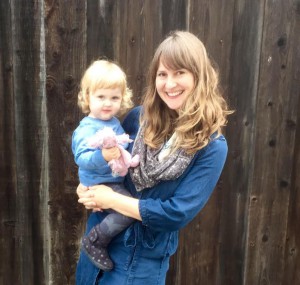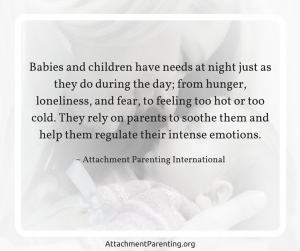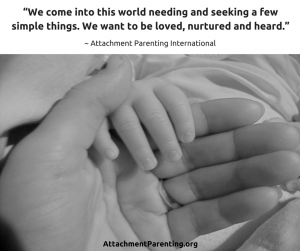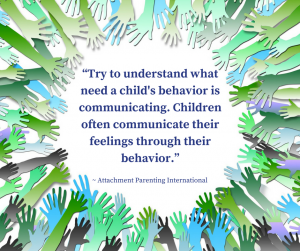Tag: nighttime parenting
All babies are born with these 3 emotional needs
Children communicate their needs through behavior…what is your child communicating?
Bedtime together, beautiful and attached
 My daughter and I stopped bedsharing a few months ago, just before her 2nd birthday. She was excited to move out of the daybed we shared in her room and into her own toddler bed.
My daughter and I stopped bedsharing a few months ago, just before her 2nd birthday. She was excited to move out of the daybed we shared in her room and into her own toddler bed.
Even though we’ve shifted away from bedsharing, bedtime still remains for us a wonderful time of connection. Sometimes I hold her and sing to her, which usually puts her to sleep before the first song is over. Most of the time, we lie together in her bed. She’ll play with my hair and cuddle up against me.
Lately, as her vocabulary and her brain continue to grow and develop, she’s been talking a lot as we lie together. She often talks about times when she was sad and frequently repeats a story about a time when I was out at the store and she was home with my husband: “I wanted you and you weren’t there, and I was crying.”
I believe this comes up often at bedtime, because it’s a time when she feels a need for comfort and knows she is safe. She can share a sad memory while knowing that I’m there for her at that moment.
I’ll listen to her story and acknowledge that it was a really upsetting time. Then I’ll remind her that in this moment she has me and I explain that now, when sadness is over, our emotions change and feeling sad is temporary. I reinforce that I am there to comfort her when she needs me.
Even though she’s no longer a newborn with an intense physiological need for me to hold her, bedtime can still be a scary time or a sad time if a child is alone. I love being able to be with her at this time and to let this be something positive and happy. While I don’t sleep with her in her bed, she still refers to it as “Mommy and me’s bed.”
When she wakes in the morning, she finds me sleeping in the daybed in her bedroom. She’ll walk over, and I’ll lift her up into bed. We’ll snuggle together until we’re ready to wake up. It’s the best part of my day and the best way to wake up. I love that I’m one of the first things she sees in the morning and that, even half-asleep, she knows that she just has to walk a few steps to find me and to feel that comfort and love. It’s beautiful to see how our sleep situation has evolved but is still a way for us to stay connected and attached.
Letting go of what you “should” do
Editor’s note: Welcome to APtly Said’s celebration of mothers! This year’s theme for Mother’s Day is “Life Lessons” as Attachment Parenting International (API) celebrates with an inspiring series from May 7-11. We hope you enjoyed your Mother’s Day and were able to reflect on what you’ve learned through your motherhood journey.
 The greatest lesson I’ve learned from Attachment Parenting (AP) is to question all assumptions. I was parented fairly traditionally, and reading about AP when I was pregnant helped me let go of certain ideas about where and when a baby should sleep, how a baby should be fed, and how a child should be disciplined.
The greatest lesson I’ve learned from Attachment Parenting (AP) is to question all assumptions. I was parented fairly traditionally, and reading about AP when I was pregnant helped me let go of certain ideas about where and when a baby should sleep, how a baby should be fed, and how a child should be disciplined.
Redefining these ideas is wonderful — and familiar to most AP families. To me, though, following API’s Eight Principles of Parenting taught me to examine standard practices and ask, Does this really work best for my family? Does my kid really need to share her sand toys with this stranger at the park? Will my preschooler starve if she doesn’t eat her dinner? Does my toddler actually need to wear pants right now? Is any of this really worth a power struggle and a tantrum, or will my child and I be just fine if I let her keep doing her thing right now?
I often hear friends who sleep-trained claim that parents who are against cry-it-out methods are simply blessed with good sleepers. If there’s follow-up to this comment, my husband and I are too busy laughing to hear it. We were blessed with a daughter who, at 2-1/2 years old, announced that she is nocturnal — and we didn’t doubt for a second that she knew exactly what she was talking about!
At 7 months, she figured out she could fight our efforts to put her to sleep and decided that sleeping from about 8 pm-midnight was sufficient. For days, she would wake around 12 am and would not go back down until 3 am. I nursed her, we walked her, we drove endlessly around the block…but nothing was putting her to sleep. Nothing worked.
Finally, we gave her what she wanted — playtime! About an hour later, she crawled in bed next to me and went to sleep. After a couple nights of this pattern, she was back to mostly sleeping through the night.
When I gave in to my child’s natural sleep pattern, we both ended up getting more sleep than we had been — and without a power struggle. For this to happen, though, I had to let go of some preconceived notions about parenting, such as that a baby needs to sleep in a crib and that babies must be pushed toward adult sleep patterns. AP explicitly told me I could question the assumption regarding baby sleep, and led me to a place where I could question another, regarding discipline — that I didn’t need to try to coerce my daughter to sleep.
Three and a half years into my parenting journey, I have certainly faced a lot of difficult moments, but I have learned to ask myself, Does this have to be hard, or do I just have to let go of something? It’s amazing how often it is the latter.
Surrendering to biologically normal toddler sleep
“Whatever you fight, you strengthen, and what you resist, persists. … Surrender is the simple, but profound, wisdom of yielding to, rather than, opposing the flow of life.” ~ Eckhart Tolle, author
 No other concept has helped me more as a mother than the concept of surrender — surrendering to the pregnancy process, to the birth process with all its twists and turns, to meeting my daughter where she is at each developmental stage and, overall, just surrendering daily to all the big and small changes that parenthood brings!
No other concept has helped me more as a mother than the concept of surrender — surrendering to the pregnancy process, to the birth process with all its twists and turns, to meeting my daughter where she is at each developmental stage and, overall, just surrendering daily to all the big and small changes that parenthood brings!
So when an article about giving a small child 1 “pass” to leave their room at night was making the rounds around the parenting cyber-world a few weeks ago, it got me thinking of how much it helped me to not pick sleep as a battle and to instead, surrender to my daughter’s needs and rhythm.
It should be said that I am not a fan of behaviorism! I don’t think trying to get my child to change a behavior without first trying to figure out why they are behaving in that way is effective or caring. I felt immediately frustrated after reading the article: It stated that crying and coming out of the bedroom were reduced to 0% rates after imposing the 1-pass rule. But I want to know, at what cost? If my child is following the 1-pass rule, they would still have the same needs — they would merely be trained not to communicate them to me, similar to sleep-training methods for babies. My toddler still might be anxious, she still might need the closeness of an adult body and, for heaven’s sake, what if she already used the pass and then actually had to pee! This 1-pass rule teaches children to ignore their emotional and physical needs.
I’d rather be asking myself:
- Why is my toddler coming to me for water, snuggles or to help fight off the monsters?
- What is the underlying need that makes it so hard for her to stay in bed?
- Why do babies and toddlers wake up so much?
- Why do so many of my friends’ children have these same “sleep problems?”
- And wait, why are we calling them “sleep problems” at all when the vast majority of babies don’t “sleep through the night” and the vast majority of toddlers struggle to go and stay asleep on their own?
 What if what our child wants is actually what they need? And how would things change if we learned that this behavior is biologically normal? Because according to many psychologists, anthropologists and researchers, it is. Would we be more open to surrender to their normal biological needs and rhythms and give our kids what they’re asking for?
What if what our child wants is actually what they need? And how would things change if we learned that this behavior is biologically normal? Because according to many psychologists, anthropologists and researchers, it is. Would we be more open to surrender to their normal biological needs and rhythms and give our kids what they’re asking for?
I don’t want to oversimplify the difficulty of adapting to wake-ups and tending to our children at night — it’s a huge change, and lack of sleep affects our bodies, minds and emotions so much. And I don’t want to call out desperate parents just trying to cope. If a family feels that this is what is needed for their family as a whole to survive, then do what you need to do. I just feel wary of the growing culture of “sleep experts” and pediatricians encouraging us to train our babies and toddlers to not call out for us at night as the default strategy for handling nighttime parenting.
This is what makes me the most sad — that behaviorism techniques are becoming the standard method, so much so that parents think that they are being manipulated or being too soft if they do normal and natural things like respond to their children, sleep with them or use so-called “crutches” like rocking, bouncing or breastfeeding. On a parenting forum I’m a part of, a new mother recently asked if it was bad to nurse her baby to sleep! This is how much this training culture has permeated our culture. Breastmilk has sleep-inducing hormones in it — it is made to put our children to sleep!
Surrendering, of course, will look different from family to family, but the knowledge of what is healthy and normal sleep for our children could hopefully give parents more confidence to follow their natural nurturing instincts. Then there wouldn’t be this overall pressure to control, fix or make our children conform to an adult standard. We could get creative about how to meet their nighttime needs, instead of placing the majority of the burden on them to meet our unrealistic expectations. Maybe if we accepted this behavior as normal instead of viewing it as problem, we could relax into their natural rhythm and flow and let go of the sleep battle altogether.
*Artwork by Katie M Berggren, www.KmBerggren.com (permission given)
We can do this in our sleep!
Editor’s note: This post was originally published on Oct. 14, 2008, but so many parents through the years since and in the future can relate well to its message.
 Nighttime has confronted us with some of the most challenging parenting moments we’ve faced so far, but being present for our now 14-month-old daughter at 3:00 in the morning is just as important as it is at any more reasonable hour.
Nighttime has confronted us with some of the most challenging parenting moments we’ve faced so far, but being present for our now 14-month-old daughter at 3:00 in the morning is just as important as it is at any more reasonable hour.
Though it isn’t always as easy, or as pleasant, as engaging her in a silly song, or reading Counting Kisses again, she doesn’t stop needing us when the sun goes down.
Our nighttime parenting has evolved in response to our daughter’s needs — and our fumbling attempts to meet them.
The day she was born, she never left our arms until after midnight, when we laid her carefully in the plastic bassinet the hospital provided before turning in ourselves. As we gazed down at our brand-new baby girl, she spit up a little — and we froze at the terrifying idea that she could choke while we slept.
Without further ado, I scooped her up and climbed into the bed, where she slept in my arms, nursing on and off the rest of the night.
When we brought her home the next day, we carefully attached an Arm’s Reach Cosleeper to our bed, eager for her to sleep close to us. We were aware of the benefits of sleeping in close proximity from reading Dr. Sears’ resources — including decreased risk of SIDS (Sudden Infant Death Syndrome) — and the Cosleeper made us feel more comfortable about sleeping next to a newborn.
But the first time we lowered our sleeping infant onto its thin mattress, she awoke immediately, howling in protest. We tried again, gently easing her from our bodies to this space where we had intended for her to sleep, but she made it clear she had other ideas.
And so the Cosleeper was relegated to serving as a makeshift nightstand, until its eventual relocation to the storage units Boise, and we began the process of trying to determine how to help our baby sleep.
As a newborn, she slept best semi-upright on our chests. When she was 5 weeks old, we discovered she was suffering from reflux, which explained her profound discomfort at lying flat on her back. But even after she outgrew the reflux at about 4 months, we still couldn’t seem to coax her to sleep for any significant length of time.
We made sure she wore comfortable PJs, was clean and dry, and had a belly full of breastmilk before bedtime each night. We tried putting her down in her crib and in her swing, with white noise and without, swaddled and unswaddled, on her back and on her side, with the nightlight on and off. And each time, about an hour after she succumbed to sleep, she’d wake and we would go try again.
We also tried cosleeping, hopeful that being close to us would provide her some comfort, but found that such proximity only stimulated her to fight sleep in order to nurse frantically all night. I awoke more than once to a find a puddle of my milk pooled under her head. So we’d try variations of other arrangements again, which would allow her to sleep more peacefully, if not for long.
We didn’t expect her to sleep through the night at 6 weeks, or even 6 months, understanding that night-waking is normal. We were more than willing to attend to her in the wee hours, and I was happy to nurse her more than once overnight.
But months of hourly — and occasionally more frequent — waking was wearing us down. Frustrated and exhausted, we stumbled through our days and nights, and desperately searched books on baby sleep for a solution. The mainstream consensus was clear: Our baby should be sleeping through the night by now, and if she wasn’t, we should “help” her by leaving her to cry it out.
We considered that advice but quickly concluded that cry-it-out methods weren’t compatible with the Attachment Parenting approach in which we believed.
Editor’s note: Parents, especially first-timers who are overwhelmed by the conflicting advice of well-meaning family members, doctors and popular parenting sources, need research-based safety information to help them make decisions for their family. Attachment Parenting International (API), in consultation with many experts in the area of infant sleep, has this information in the form of an Infant Sleep Safety Guidelines brochure and wants to get it into the hands of parents everywhere to ensure that all babies can be safe during sleep, at night and at naptime, regardless of whether you share sleep in the same bed, use a cosleeping bassinet, or use a crib.
At some point, we accepted that there probably wasn’t a silver bullet for our sleep struggles. The answer to the question of what to do for our daughter, a restless sleeper with high nocturnal needs, was simple and one we’d known all along: When she cried, we would respond. Every time.
Sometimes I nursed her as soon as she stirred. Sometimes her Dada snuggled with her or patted her bum softly until she drifted back into slumber. We continued to bring her into our bed, and finally, one night when she was almost 11 months old, she finished nursing, rolled over and went to sleep. It was the first night she’d actually slept next to me without nursing for a few hours, and she hasn’t been back in her crib since.
Cosleeping feels right for us.
Though she still stirs often throughout the night, just being beside us seems to lengthen each stretch of snooze. Finally we can comfort her without waking ourselves! And when she does arouse, if she isn’t easily soothed back to sleep, she nestles next to me and nurses, and we doze off together again.
Of course there are nights when we find ourselves exasperated at the fact that we haven’t enjoyed a night of unbroken sleep for over a year, but we are committed to giving her our presence even when it isn’t easy to do so. And when the sun comes up on her sweet face between my husband and me, I wouldn’t want any of us to be anywhere else.
Disclaimer: API urges parents to use good sense regarding the safety of their children. API publishes this information knowing that parents are engaged in the use of cribs and cosleeping in all its forms, and as such, API is committed to keeping children safe and healthy by providing the most current safety information available. API, its Support Groups, its sponsors and its partners assume no liability in the event of infant, child or parent harm and are held harmless from any harm, loss or legal arising from information they provide.
How do you cosleep?
Editor’s note: Attachment Parenting International (API) advocates for a parenting approach rooted solidly in research, and continuing research further validates and builds upon API’s foundation. API is excited to collaborate with Salem State University in the development of this opportunity for AP parents to share how they practice Attachment Parenting (AP) in their home, specifically regarding cosleeping:
I have been involved in Attachment Parenting research for many years, both as a practitioner and as a researcher.
I am currently conducting a study about families who are continuing to cosleep with children at a variety of ages and may either be considering transitioning the child to their own bed or room, or have already gone through this transition.
I would also like to hear from parents who can’t imagine this as of yet or even ever.
As such, please complete the survey and share the link with others who may be interested. Access the survey link through the API Forum. (You will need to use your forum login; if you don’t have one, it’s free to join.)
The survey is a little bit long at 41 questions, but this information hasn’t been collected anywhere, so it would be great to have it out there!
This study has been approved by Salem State University’s IRB.
I may be reached at pmiller@salemstate.edu with any questions. I would love hearing from you!
Thank you very much,
Patti Miller, Salem State University




